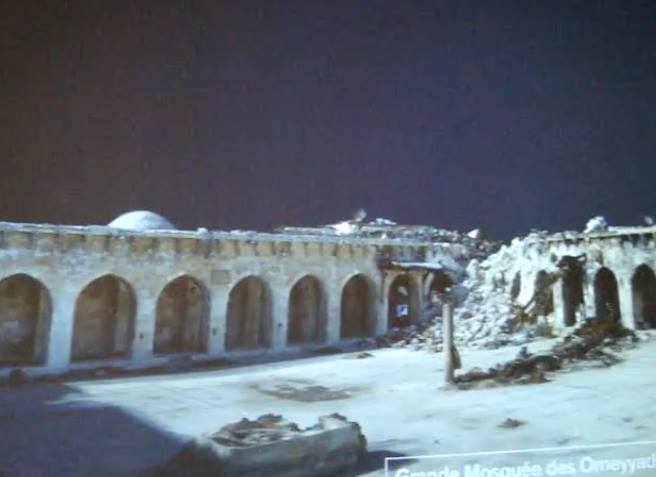The historic Syrian cities of Aleppo and Palmyra were presented as part of the Endangered Heritage Protection Fair at the Institute of the Arab World in Paris this week, with the participation from the Louvre Museum and the United Nations Educational, Scientific and Cultural Organization (UNESCO), organized in order to shed light on world heritage sites that are exposed to destruction and extinction.
The fair was launched on Wednesday and will continue till Feb. 10, 2019. This exhibition offers visitors high-definition, three dimensional videos, showing the huge destruction that fell upon these cities which are deeply rooted in history and which are an expression of the beginning of human existence in the region.
However, the exhibition did not refer to or point out to the real agents of destruction of the city of Aleppo and of Palmyra. The ‘State Organization' was the only partly mentioned and blamed for the destruction. This evasiveness angered Syrian attendees and motivated their ruthless criticism. They requested for things to be called by their names and for perpetrators to be directly pointed at, stressing that the criminals of this era form one big alliance and that they take shifts in the destruction of the world heritage starting with Bashar al-Assad, Vladimir Putin, Shiite militias to the ‘State Organization’.
Dr. Anas al-Miqdad, a researcher in the archeology at the Sorbonne University, says: “Unfortunately, the Fair only mentions the Islamic State (ISIS) in regards to the destruction of the cities and completely disregards the roles of Russia and Bashar Assad in the demolition of Aleppo.
A symposium on the endangered historical monuments in Syria, Iraq, Yemen and Libya was held, but Syrian specialists in archeology were absent from this symposium. They were supposed to discuss the catastrophic and critical situation of our heritage and monuments. The focus instead shifted to the protection of religious minorities through the presence of the Association of Christians in the East and especially the protection of Yazidis."
He added to Zaman al-Wasl: "This is unfortunate, because it is necessary to focus on the protection of man as a human being, away from race, religion or ethnicity … and to protect our human heritage before any other specificity." There was according to him, no condemnation of the Assad regime, or Russia, or the United States whose planes have destroyed the city of Mosul which is one of cities that the fair talks about.
He also indicated that UNESCO, one of the organizers of the exhibition, has been in contact with the Assad regime since the beginning of the Syrian revolution in 2011, and is still representative of its legitimate functioning as a government. UNESCO’s office in Beirut has also been funding projects of the General Directorate of Antiquities and Museums of the Assad regime for years.
Miqdad criticized the organizers for not allowing the attendees at the exhibition to intervene and express themselves and connect the reality of what happened on the ground. He, nonetheless, stressed that the exhibition is very important to identify and communicate the extent of the destruction of historic cities and historic sites to visitors; it is also a valuable photographic document that can be used scientifically.
The city of Aleppo and its suburbs were filmed, and we see through video and digital photography the Aleppo Castle and the Umayyad Mosque and its current state of destruction, especially its courtyard. The complete annihilation of the old markets of the city of Aleppo and how it was before the destruction was filmed. They also exhibited the full destruction of the ancient city of Palmyra, where we can see the complete demolition of the temple of Baal Shamin and the attempt to restore it and the Burial towers destroyed and the center of the old city. We also see the Burial Cemeteries being destroyed barbarically by ISIS as well as the old city center.”
In addition to the cities of Aleppo and Palmyra, the Fair represented the city of Mosul in Iraq and the city of Libda in Libya. The Libyan audience was officially represented by the Director General of Libyan Antiquities and his accompanying delegation.
As a result of the Russian airstrikes, residents of the eastern part of the city of Aleppo were forced to flee their homes on Dec, 22, 2016.
This article was edited by The Syrian Observer. Responsibility for the information and views set out in this article lies entirely with the author.


